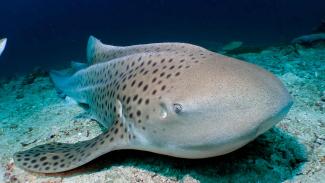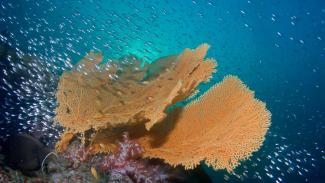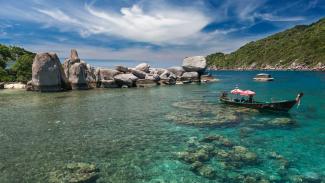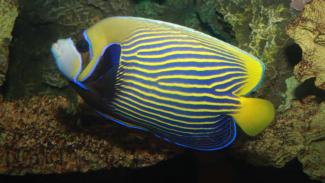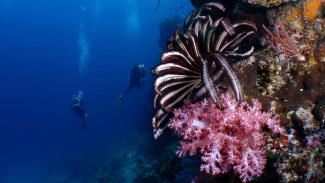Our essential guide to the best scuba diving in Thailand
Thailand is one of the most popular destinations in the world for scuba-diving - and for good reason.
Koh Tao, Phuket and Ko Phi Phi are very popular places to learn to dive, while the Similan and Surin Islands make a fantastic introduction to the world of liveaboard diving.
The best scuba diving in Thailand is concentrated along the southern peninsula, with options on both the east and the west coasts. When conditions on one coast are not ideal, the opposite coast often has good conditions, providing options for divers throughout the year.
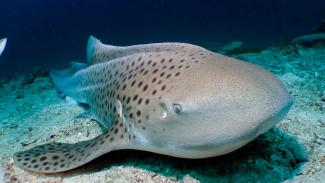
Tara North
Highlights
Thailand's best dive sites
The diving is generally located around offshore islands offering fringing reefs, pinnacles & even offshore sea mounts that attract plenty of pelagic action.
The west coast faces the Andaman Sea and offers excellent diving all the way up the coast. In the southern Andaman, Koh Lipe has a few dive operators & Koh Lanta is well placed to offer diving to many top dive spots. Koh Phi Phi & Phuket also offer excellent diving opportunities and further north, the stunning Similan & Surin Islands are mainly reached by liveaboards from Phuket & Khao Lak.
On the east coast, most of the diving is concentrated around Koh Tao, the northern most of 3 popular tourist islands in the Gulf of Thailand; Kho Samui, Koh Phang-ngan & Koh Tao. It is possible to reach the best sites from all 3 islands, with Samui offering the most developed tourist facilities, but also the longest journey times to dive sites.
There is also diving on other islands on the east coast, such as Pattaya, just a short distance from Bangkok & Ko Chang, a little further east.
Keen to find out more? Skip on through to our detailed review of all of Thailand's best diving destinations.
Best marine life in Thailand
Thailand is renowned for warm tropical waters and vibrant coral reefs playing host to a wide variety of marine life.
The country’s most famous visitors are Manta Rays & Whalesharks, which can be seen on both coasts if you are lucky. The dive spots most renowned for sightings are Richeleu Rock - just north of the Similan islands, Hin Daeng & Hin Muang in the Southern Andaman & Chumpon Pinnacle in the Gulf.
Leopard Sharks are another sought after encounter, found most commonly on the dive sites around Koh Phi Phi and Phuket. These elegant, bottom dwelling sharks are at their graceful best if you are fortunate enough to see them swimming.
Turtles are found on both coasts of Thailand, although more regularly on the Andaman coast. Green and Hawksbill Turtles are the most common species seen.
Thailand’s dive sites also play host to a wide variety of smaller marine life, including some very special finds. Octopus and Cuttlefish are regularly seen, while Seahorses, Ghost Pipefish and Harlequin Shrimps are delights for the eagle-eyed diver. Scorpionfish, Lionfish, Glassfish and Snapper are just a few of the other fish you might encounter while diving in Thailand.
Ease of Travel
Traveling around Thailand is both cheap & easy. There are international airports in Bangkok, Phuket & Ko Samui offering easy access to almost all Thailand’s best diving areas. There is also a wide range domestic budget airline options & reliable bus, train & ferry connections.
People
Thailand is famous the world over for its friendly people, tolerant attitude & great food. The country’s 70 million inhabitants are predominantly Buddhist, while the southern tourist islands on the Andaman coast are Musilm. The north is home to many traditional & culturally unique hill tribes.
Safey
Thailand is a very popular and safe place to visit, with many friendly locals & great tourist facilities. In built up areas, petty crime is occasionally a problem and some political unrest continues in the deep south of the country, although this does not affect the main dive destinations in any way.
When is the best time to dive in Thailand?
Thailand’s east and west coasts ensure that there are good diving possibilities throughout the year. When the seasonal monsoons affect one coast, the other normally has good diving conditions.
On Thailand’s Andaman coast the best diving season is from November through to late April or early May. The wind direction during these months brings calm sea conditions and also the best weather. The very best conditions are often from January through to March, with consistent blue skies and sparkling seas. As the high season on the Andaman coast develops, humidity tends to increase ,but diving conditions remain excellent and sea temperatures are also at their warmest, sometimes in excess of 85 degrees Fahrenheit. On this coast, February through to May also tends to bring the best opportunities to see Manta Rays and Whale Sharks around the Surin Islands or farther south at Hin Daeng and Hin Muang.
Somewhere between late April and the end of May each year, the wind direction changes and there is more rainfall, affected by the Indian monsoonal weather patterns. When conditions allow, scuba diving remains good, but rougher sea conditions mean diving can make diving less enjoyable. This is reflected in the Similan liveaboard season, which runs from November through to the end of April.
On Thailand’s eastern coast, the best diving is usually from March to September. During these months, Thailand’s best scuba diving opportunities move to the Gulf of Thailand. April and May can have lower visibility, but that brings the possibility of larger marine life, with Whale Sharks sometimes seen around Koh Tao. June and July tend to bring the best visibility. October to February brings higher rain and more difficult diving conditions in the Gulf of Thailand.

Valeriy Ryasnyanskiy

Tara North
Liveaboard diving in Thailand
Imagine picture perfect tropical islands tumbling into warm blue water, and hiding colourful tropical reefs. You have just pictured the Similan Islands, Thailand’s liveaboard diving mecca. One of the classic liveaboard destinations, the Similan Islands, along with the Surin Islands to the north, make an ideal destination for eager liveaboard divers.
There is a variety of dive sites to enjoy, from the distinctive granite boulders and swim-throughs to coral bommies teeming with life, the possibility of Whale Sharks at Richelieu Rock to Manta Rays at Koh Bon.
Looking for the latest liveaboard deals in Thailand? Find your deal
There are a range of itineraries to choose from. Liveaboards start from just 3 days in duration, making them a perfect introduction for those who have not tried liveaboard diving before. These shorter liveaboard itineraries tend to focus on either the Similan Islands or the Surin Islands. Longer itineraries of 4-6 days take in the best dive sites of the entire region, while other itineraries combine the Similan and Surin islands with the Mergui Archipelago over the border in Myanmar’s waters.
There are a wide range of liveaboard operators to choose from. The majority of liveaboards begin from Tap Lamu Pier, just south of Khao Lak. This makes Khao Lak a great base for before or after your Thailand diving liveaboard. Certain liveaboards depart from the south of Phuket, but itineraries offered are very similar. Liveaboards in Thailand tend to be quite good value; another reason why they are popular with divers taking their first steps into the world of liveaboard diving.



